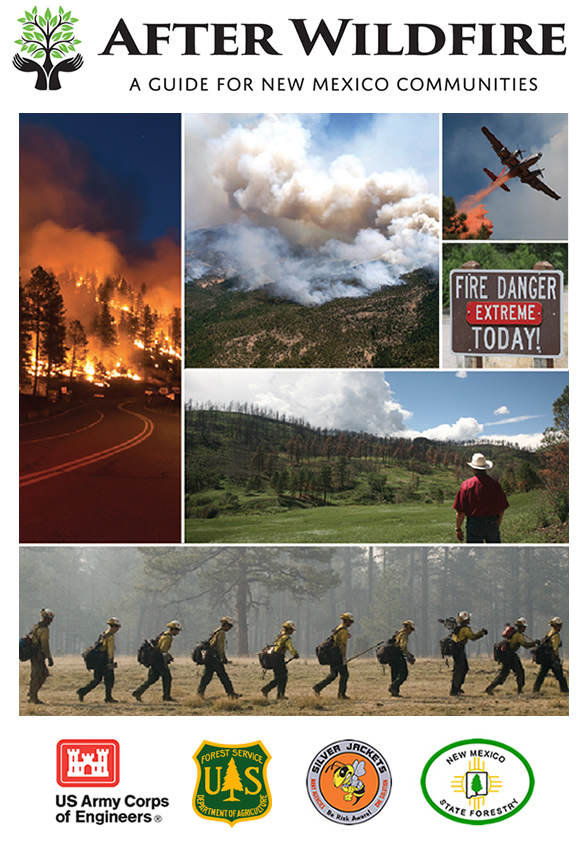
Immediate Safety
Although wildfire damage can be immense, often the danger is not over after the flames are put out. Flash flooding, structural damage, road instability and damaged trees are just some of the dangers that landowners face after a wildfire. Keep these tips in mind:
If you feel you are in danger, call 911 or your local emergency number.
- Stay away from your home or business until fire officials tell you it is safe to return.
-
Flash floods are a very real and potentially deadly hazard after a wildfire, particularly as a result of rain falling over a burned area upstream of your location. Stay away from storm channels and arroyos (ditches are deadly, especially after a wildfire). Keep a battery-powered radio to listen for emergency updates, reports of weather and flash flooding, and news reports. For more information, visit our flood section here.
-
Have an evacuation plan in place and make sure all family members know it in case you need to leave your home for any reason.
-
Do not drink or use water from the faucet until emergency officials say it is okay; water supply systems can be damaged during wildfires or flooding. Visit the NMED Drinking Water Bureau website for more information, or call 877-654-8720 Monday - Friday, 8-5, for more information.
-
Be aware of and use extreme caution around trees, power poles and other tall objects that may have lost stability during the fire. Most burned structures and surfaces will be unstable. Stay out of burned forests in windstorms as burned trees are easily downed by wind. Do not touch any power lines.
-
Utilities: If there is no power, check to make sure the main breaker is on. If the breakers are on and power is still not present, contact the utility company. If you have a propane tank or system, contact a propane supplier, turn off valves on the system, and leave valves closed until the supplier inspects your system. If you have a heating oil tank system, contact a heating oil supplier for an inspection of your system before using.
-
Before beginning any cleanup effort, document damage with photographs and contact your insurance carrier.
-
Finally, use caution and good judgment. Ultimately you are responsible for your own safety and well-being.
-
Keep a “fire watch.” That means look for smoke or sparks throughout the house and on rooftops (such as in gutters), etc. Look for ash pits or hidden embers. Stay away. They can burn you.
-
Use a battery-powered flashlight to inspect a damaged home. (Note: the flashlight should be turned on outside before entering – the battery may produce a spark that could ignite leaking gas, if present).
-
For information on caring for pets and livestock after wildfire, click here.
-
Finally, use caution and good judgment. Most burned structures and surfaces will be unstable. Ultimately you are responsible for your own safety and well-being.
Additional Safety Resources
Wildfire
- Wildfire Information: click here.
Weather and Emergency Alerts
- The National Weather Service provides active alerts on weather across the nation.
- NOAA Weather Radio provides 24/7 information on watches, warnings and advisories from the National Weather Service. It does not cover all areas of New Mexico, and does require a special receiver that can be purchased at many retail outlets for less than $40 USD.
- The Emergency Alert System broadcast flash flood warnings commercial radio and TV.
- Wireless Emergency Alerts (WEA) are emergency messages sent by authorized government alerting authorities through your mobile carrier, and include flash flood warnings. Mobile users are not charged for receiving these text-like alerts and are automatically enrolled to receive them.
- FEMA recently launched an app that provides email alerts and text messages to the general public.
- Third party sources that deliver email and weather alerts are listed here.
- Nixle provides free text and email alerts anywhere in the nation.
Water and Smoke
- The NMED Drinking Water Bureau website provides information on drinking water safety, or call 1-877-654-8720 Monday - Friday, 8-5 pm.
- Smoke Inhalation and your health: for information on how to help protect your health from wildfire, visit the New Mexico Department of Health here.
Pets and Livestock
- Contact your local animal control office or county extension office to find out if a pet or livestock shelter has been set up. For contacts and information, visit our 'Who Can Help' section on animals here.